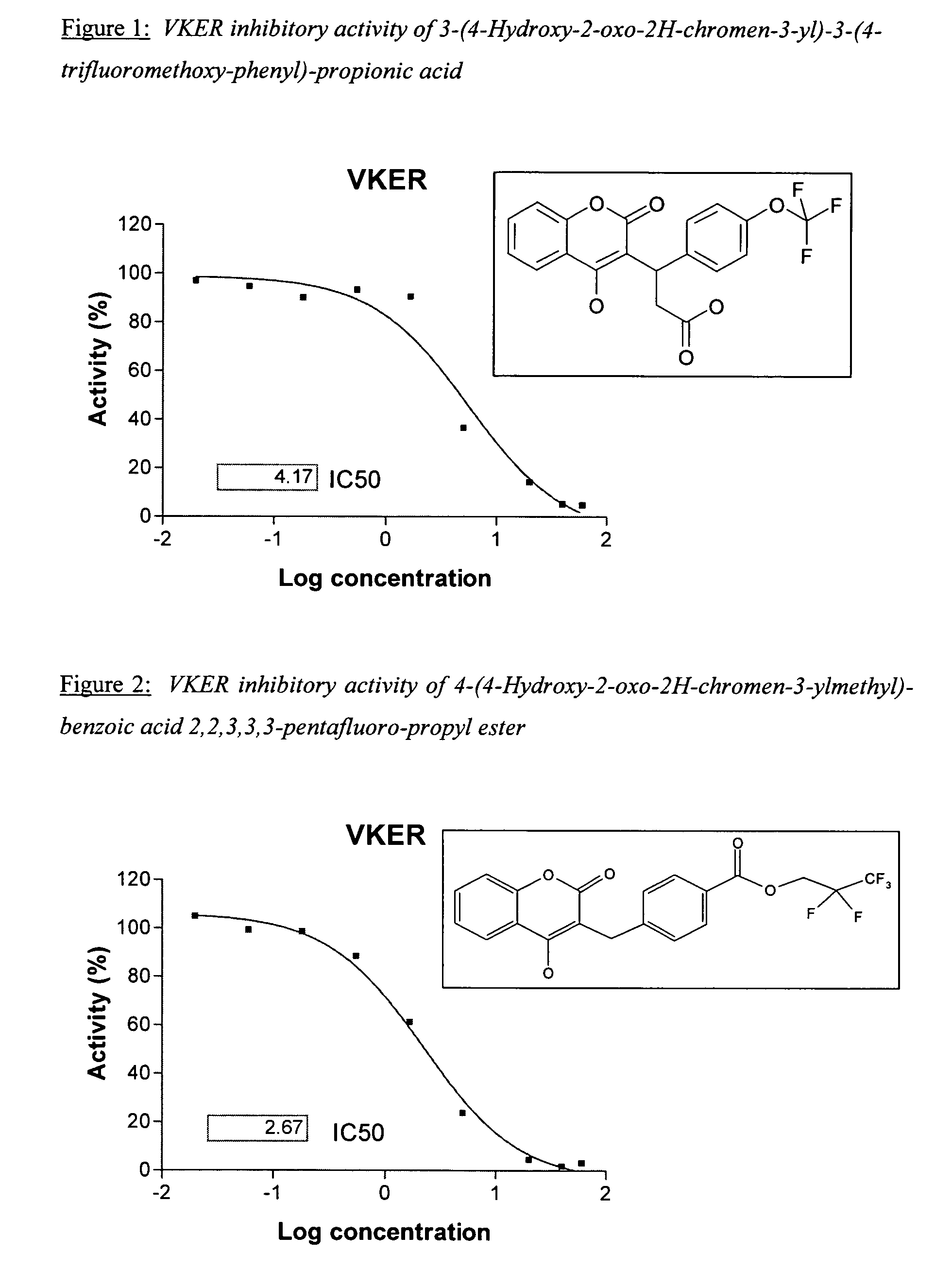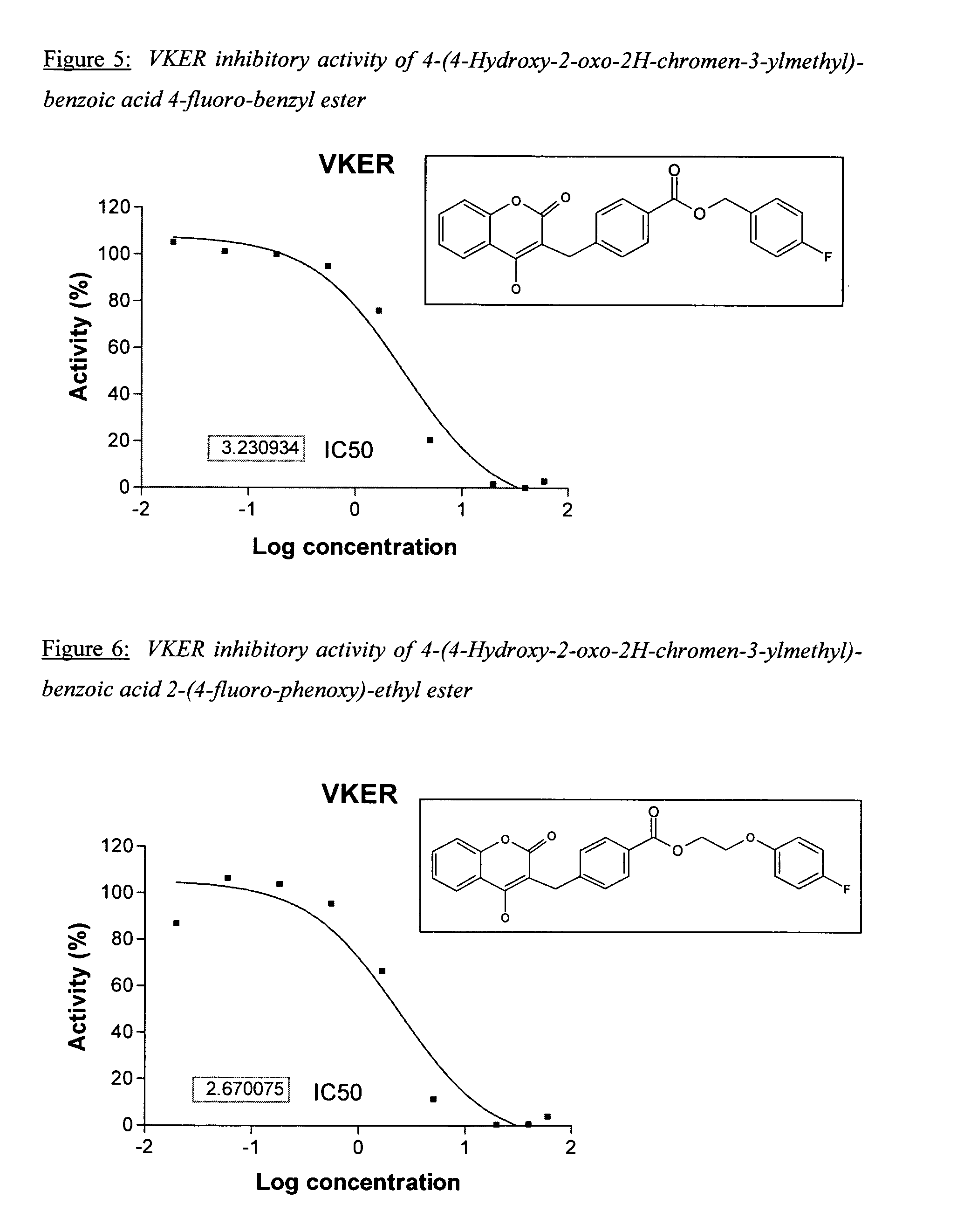Materials and methods for treating coagulation disorders
a technology of coagulation disorders and materials, applied in the field of materials and methods for treating coagulation disorders, can solve the problems of inhibiting vitamin k regeneration, serious and possibly fatal sequelae, adverse effects,
- Summary
- Abstract
- Description
- Claims
- Application Information
AI Technical Summary
Benefits of technology
Problems solved by technology
Method used
Image
Examples
example 1
Preparation of 4-(4-Hydroxy-2-oxo-2H-chromen-3-ylmethyl)-benzoic acid 2,2,2-trifluoro-1-methyl-1-trifluoromethyl-ethyl ester
[0772]
[0773]Triethylammonium formate (TEAF) is prepared by adding TEA (20.0 mL) to formic acid (16.5 mL) with ice cooling. To TEAF is added 4-(2,2,2-trifluoro-1-methyl-1-trifluoromethyl-ethoxycarbonyl)benzaldehyde (3.78 mL) and 4-hydroxy-chromen-2-one (6.0 g) and the resulting mixture heated to 130–140 ° C. for 3 hours, cooled to room temperature, diluted with water, and extracted with EtOAc.
[0774]The organic layer is washed with brine, dried over MgSO4 and conc. in vacuo to give a light yellow solid. The crude solid is recrystallized from EtOH to give 4-(4-Hydroxy-2-oxo-2H-chromen-3-ylmethyl)-benzoic acid 2,2,2-trifluoro-1-methyl-1-trifluoromethyl-ethyl ester (1.95 g).
example 2
Preparation of 4-Hydroxy-3-(3-oxo-1,3-dihydro-isobenzofuran-1-yl)-chromen-2-one
[0775]
[0776]A solution of 4-hydroxy-chromen-2-one (650 mg) and 2-carboxybenzyladehyde (300 mg) in EtOH is heated to reflux for 4 hours, cooled to room temperature then concentrated in vacuo to give a crude oil, which is diluted with water.
[0777]The precipitated 4-hydroxy-chromen-2-one is collected by filtration (490 mg). A second crop of solid is collected from the mother liquor and triturated with hot EtOAc and filtered to provide 4-Hydroxy-3-(3-oxo-1,3-dihydro-isobenzofuran-1-yl)-chromen-2-one as white solid.
example 3
Preparation of 2-(4-Hydroxy-2-oxo-2H-chromen-3-ylmethyl)-benzoic acid chloromethyl ester
[0778]
[0779]To a solution 4-Hydroxy-3-(3-oxo-1,3-dihydro-isobenzofuran-1-yl)-chromen-2-one (60 mg) in ethanol is added 10% Pd / C (10 mg) then stirred under a hydrogen balloon for 12 hours. The reaction mixture is filtered through a pad of celite and the filtrate concentrated in vacuo to give 2-(4-Hydroxy-2-oxo-2H-chromen-3-ylmethyl)-benzoic acid as white solid (50 mg). MS: 295[M−H].
[0780]A solution of 2-(4-Hydroxy-2-oxo-2H-chromen-3-ylmethyl)-benzoic acid in a 5% sodium bicarbonate solution is added to a solution of 1.5 equivalent of chloromethylchlorosulfate in methylene chloride. Tetrabutylammonium hydrogensulfate (catalytic amount) is added, and the mixture stirred vigorously for 5 hours. The organic layer is dried over MgSO4 and conc. in vacuo to give 2-(4-Hydroxy-2-oxo-2H-chromen-3-ylmethyl)-benzoic acid chloromethyl ester as white solid.
PUM
| Property | Measurement | Unit |
|---|---|---|
| coagulation time | aaaaa | aaaaa |
| enantiomeric excess | aaaaa | aaaaa |
| enantiomeric excess | aaaaa | aaaaa |
Abstract
Description
Claims
Application Information
 Login to View More
Login to View More - R&D
- Intellectual Property
- Life Sciences
- Materials
- Tech Scout
- Unparalleled Data Quality
- Higher Quality Content
- 60% Fewer Hallucinations
Browse by: Latest US Patents, China's latest patents, Technical Efficacy Thesaurus, Application Domain, Technology Topic, Popular Technical Reports.
© 2025 PatSnap. All rights reserved.Legal|Privacy policy|Modern Slavery Act Transparency Statement|Sitemap|About US| Contact US: help@patsnap.com



